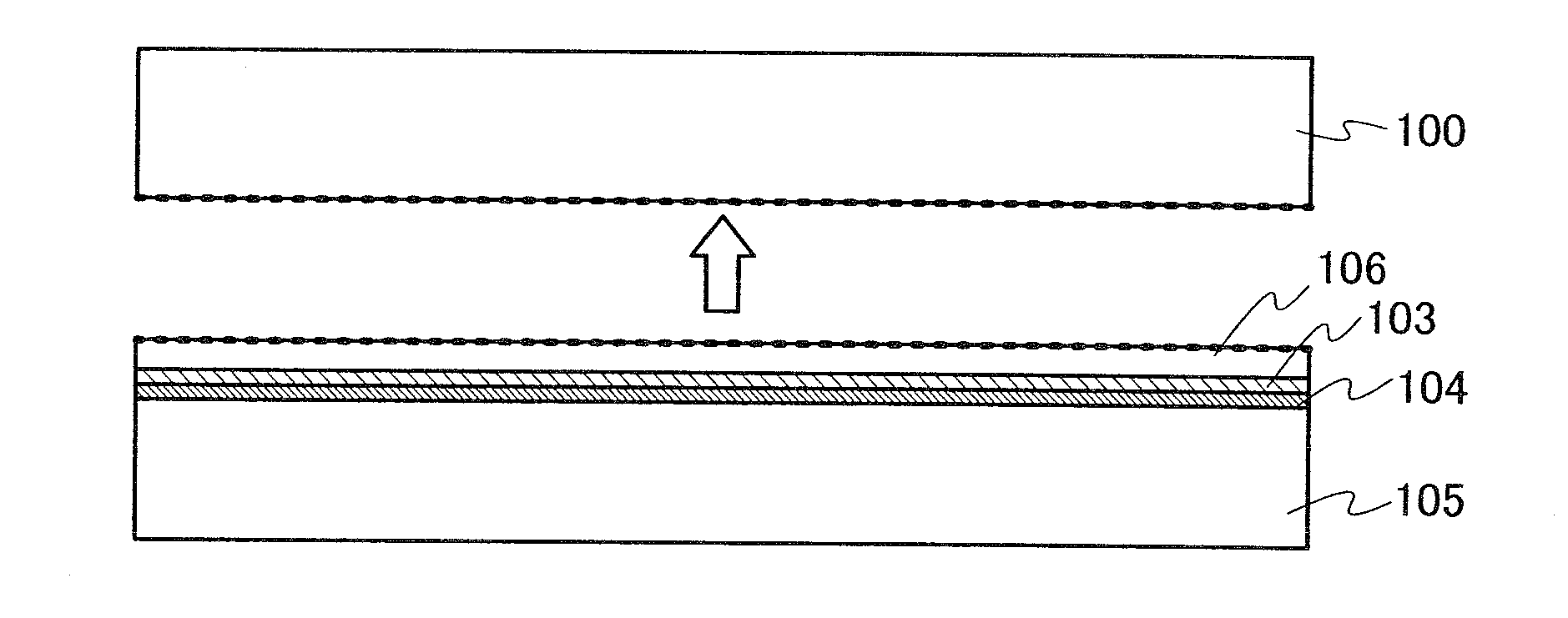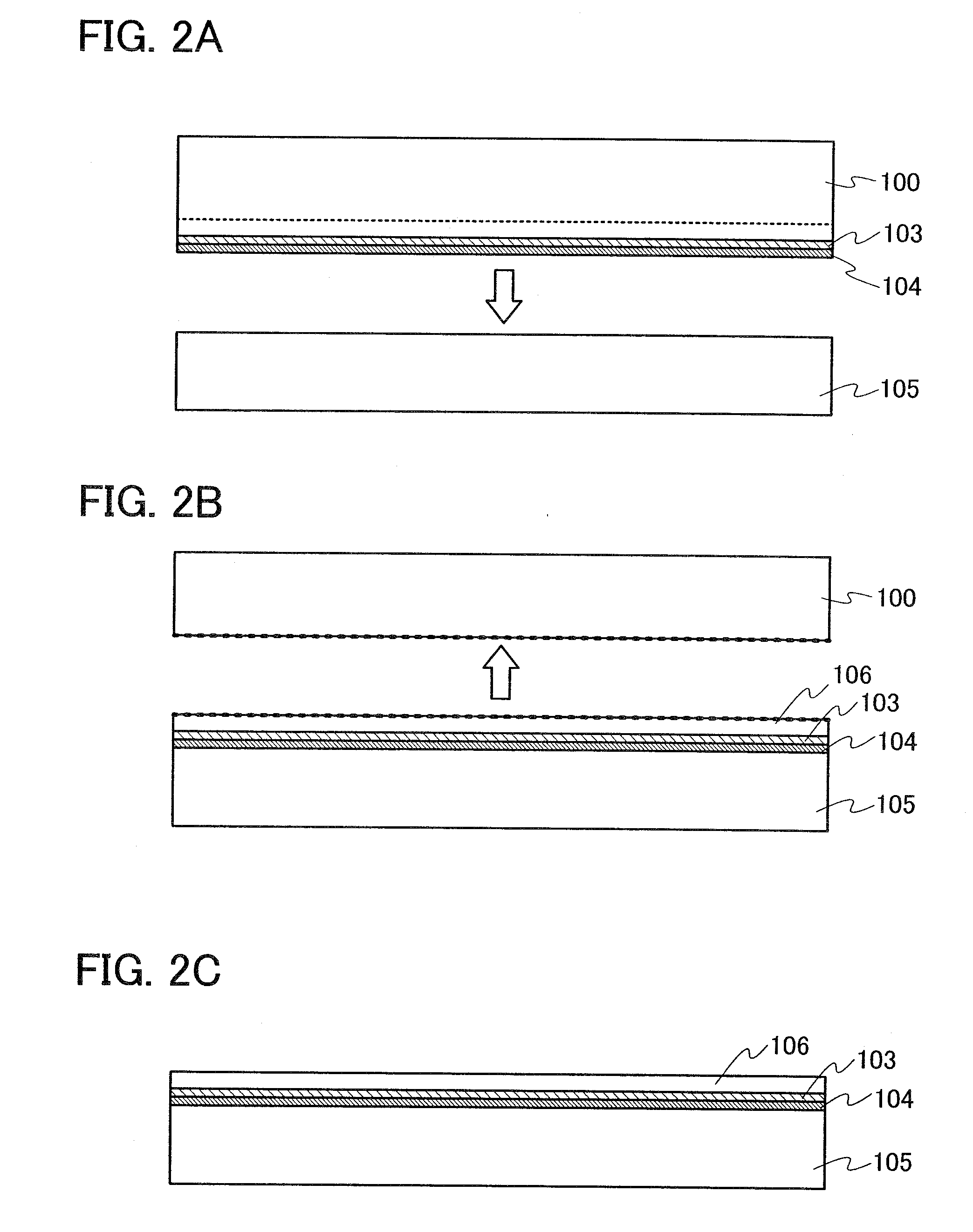Method of manufacturing semiconductor device
a manufacturing method and semiconductor technology, applied in the direction of semiconductor devices, basic electric elements, electrical appliances, etc., can solve the problems of reducing the reliability of semiconductor devices manufactured using soi substrates, reducing the electrical characteristics of transistors, and increasing threshold voltage and leakage current, so as to reduce reliability, suppress the amount of impurities entering the semiconductor film over the base substrate, and prevent the effect of impurities
- Summary
- Abstract
- Description
- Claims
- Application Information
AI Technical Summary
Benefits of technology
Problems solved by technology
Method used
Image
Examples
embodiment mode 1
[0034]In this embodiment mode, a method of manufacturing a semiconductor device of the present invention is described.
[0035]First, a bonding substrate 100 is cleaned and then an insulating film 101 is formed over the bonding substrate 100, as shown in FIG. 1A. As the bonding substrate 100, a single crystal or polycrystalline semiconductor substrate formed of silicon, germanium, or the like can be used. Alternatively, a single crystal or polycrystalline semiconductor substrate formed of a compound semiconductor such as gallium arsenide or indium phosphide can be used as the bonding substrate 100. Further alternatively, a semiconductor substrate formed of silicon having crystal lattice distortion, silicon germanium which is obtained by adding germanium to silicon, or the like may be used as the bonding substrate 100. Silicon having distortion can be formed by formation of silicon on silicon germanium or silicon nitride which has larger lattice constant than silicon.
[0036]The bonding s...
embodiment mode 2
[0117]Unlike Embodiment Mode 1, this embodiment mode describes a method of manufacturing a semiconductor device of the present invention, in which the fragile layer 102 is formed before the formation of the insulating film 103.
[0118]First, after cleaning the bonding substrate 100, an ion beam including ions accelerated by an electric field is delivered to the bonding substrate 100 as indicated by arrows, whereby the fragile layer 102 having very small voids is formed in a region at a predetermined depth from a surface of the bonding substrate 100, as shown in FIG. 4A. The depth at which the fragile layer 102 is formed can be adjusted by the acceleration energy of the ion beam and the angle at which the ion beam enters. The acceleration energy can be adjusted by acceleration voltage, dosage, or the like. The fragile layer 102 can be formed at the same depth or substantially the same depth as the average depth at which the ions have entered. The thickness of the semiconductor film 106...
embodiment mode 3
[0146]This embodiment mode describes a method of manufacturing a thin film transistor, one of semiconductor elements, as an example of a method of manufacturing a semiconductor device with use of a base substrate with a semiconductor film attached, a so-called SOI substrate. A variety of semiconductor devices can be formed by combination of a plurality of thin film transistors.
[0147]First, the semiconductor film 106 over the base substrate 105 is processed (patterned) into a desired shape by etching, thereby forming semiconductor films 603 and 604 as shown in FIG. SA.
[0148]In order to control threshold voltage, a p-type impurity such as boron, aluminum, or gallium or an n-type impurity such as phosphorus or arsenic may be added to the semiconductor films 603 and 604. For example, in the case of adding boron as the p-type impurity, boron may be added at a concentration in the range of 5×1016 atoms / cm3 to 1×1017 atoms / cm3. The impurity for controlling the threshold voltage may be adde...
PUM
 Login to View More
Login to View More Abstract
Description
Claims
Application Information
 Login to View More
Login to View More - R&D
- Intellectual Property
- Life Sciences
- Materials
- Tech Scout
- Unparalleled Data Quality
- Higher Quality Content
- 60% Fewer Hallucinations
Browse by: Latest US Patents, China's latest patents, Technical Efficacy Thesaurus, Application Domain, Technology Topic, Popular Technical Reports.
© 2025 PatSnap. All rights reserved.Legal|Privacy policy|Modern Slavery Act Transparency Statement|Sitemap|About US| Contact US: help@patsnap.com



